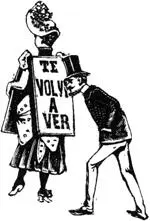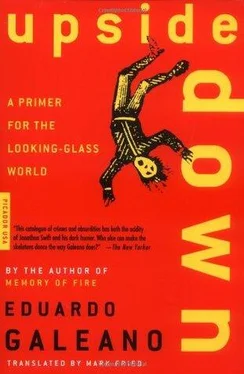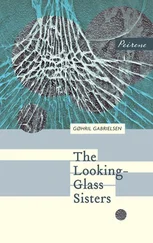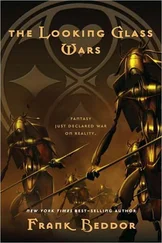The Great Day
They live off garbage amid garbage, eating garbage in garbage houses. But once a year, the garbage collectors of Managua star in the show that draws the country’s largest crowds. “The Ben-Hur Races” were the inspiration of a businessman who came back from Miami to do his part for “the Americanization of Nicaragua.”
Riding their garbage carts, fists in the air, Managua’s garbage collectors salute the president of the country, the ambassador of the United States, and the other dignitaries who grace the dais of honor. Over their everyday rags, the competitors wear broad colorful capes, and on their heads sit the plumed helmets of Roman warriors. Their dilapidated carts are freshly painted, the better to display the names of their sponsors. The skinny horses, covered with open sores like their owners and punished like their owners, are corsairs that fly to the finish line for the sake of glory, or at least a case of soda.
Trumpets blare. The starting flag drops, and they’re off. Whips beat down on the bony haunches of the sorry nags, while the delirious crowd cheers: “Co-ca-Co-la! Co-ca-Co-la!”

Consumer culture, ephemeral culture, condemns everything to immediate obsolescence. Everything changes at the dizzying pace of fashion, at the service of the need to sell. Things grow old in the blink of an eye, only to be replaced by other things no less short-lived. When only insecurity is permanent, merchandise made to wear out is as volatile as the capital that finances it and the labor that produces it. Money flies at the speed of light — yesterday it was over there, today it’s here, tomorrow who can say — and every worker is a potential recruit for the vast army of the unemployed. Paradoxically, it’s shopping malls, the kingdoms of fleeting fashion, that offer the most successful illusion of security. They seem to exist beyond time, ageless and rootless, without night or day or memory, and outside of space, apart from the turbulence of dangerous reality.
The Global Field
In its current form, soccer was born over a century ago. It was born speaking English, and it still speaks English everywhere it’s played. But now you hear it singing the praises of a good “sponsor” and lauding the virtues of “marketing” with as much fervor as it used to commend a good “forward” and the art of “dribbling.”
Tournaments are named for those who pay, not those who play. The Argentine championship is called Pepsi-Cola. Coca-Cola is the name of the world youth soccer tournament. The intercontinental club tournament is called the Toyota Cup.
For the fan of the most popular sport in the world, for the fanatic of the most universally fanatical passion, a team’s shirt is a sacred mantle, a second skin, his other breast. But the shirt has also become a walking billboard. In 1998, players for Rapid of Vienna wore four advertisements at once. On their shirts were ads for a bank, a company, and a brand of cars, and on their shorts they advertised a credit card. When River Plate and Boca Juniors play each other in Buenos Aires’s soccer classic, it’s Quilmes against Quilmes: both teams wear the name of the same brand of beer. In this era of globalization, River also plays for Adidas and Boca for Nike. In fact, you could say Adidas beat Nike when France defeated Brazil in the final of the 1998 World Cup.

In these sanctuaries of well-being, you can do everything without ever stepping into the dirty, threatening outdoors. In some, you can even sleep. The newest ones, in places like Los Angeles and Las Vegas, include hotels and health clubs. Oblivious to cold or heat, malls are safe from pollution and violence. Michael A. Petti publishes scientific advice in a syndicated column called “Live Longer.” In cities “with poor air quality,” Dr. Petti suggests that those who wish to live longer should “walk inside shopping centers.” Atomic clouds of pollution hang over Mexico City, São Paulo, and Santiago, and on the corners muggers lie in wait, but in this carefree world outside the world — with its filtered air and guarded walkways — you can breathe and walk safely.
Malls are all more or less alike, in Los Angeles or Bangkok, in Buenos Aires or Glasgow. Uniformity, however, doesn’t keep them from competing for clients by inventing new come-ons. At the end of 1991, for example, Veja magazine praised a novelty from Praia de Belas mall in Pôrto Alegre, Brazil: “For baby’s comfort, they provide strollers to help these small consumers move about.” But security is the most important item offered by all shopping centers. A luxury on the outside, it can be had by anyone who penetrates these bunkers. In its infinite generosity, consumer culture issues safe-conduct passes so we can flee the hell of the streets. Surrounded by parking lots like vast moats, these island kingdoms provide closed and protected spaces where people cross paths drawn by the urge to have, the way people used to meet, drawn by the desire for companionship, in the cafés or plazas, parks or markets of old. The public police and the private police, the visible police and the invisible police make sure anyone suspicious gets tossed into the street or thrown into jail. Poor people who don’t manage to disguise their congenital malevolence, especially dark-skinned ones, are guilty until proven innocent. And if they happen to be children, so much the worse. Malevolence is inversely proportional to age. Way back in 1979, Colombia’s police reported to the South American Police Congress that their juvenile division had no choice but to give up social work so that they could “undercut the evil deeds” of dangerous minors and “avoid the nuisance of their presence in shopping centers.”
The Injection
More than half a century ago, a writer named Felisberto Hernández published a prophetic tale. A man dressed in white and carrying a syringe boards streetcars in Montevideo and amiably injects the arms of all the passengers. Immediately they hear advertising jingles from the Canary furniture factory. To get the ads out of their veins, they have to go to the drugstore for Canary pills that suppress the effect of the shot.
These gigantic supermarkets turned into miniature cities are also guarded by electronic control systems, eyes that see without being seen, hidden cameras that follow the steps of the crowd wandering amid the merchandise. Electronics are useful not only for watching and punishing undesirables who might succumb to the temptation of forbidden fruits but for making consumers consume more. In the cybernetic age, when the right to citizenship is based on the duty of buying, large companies take X rays of every citizen’s habits, calling up data from credit card, bank machine, and e-mail use to discern a potential customer’s earnings and yearnings — and then pummel him with advertising. This happens more and more in highly developed countries, where commercial manipulation of the on-line world freely violates private life and places it at the service of the market. It has become increasingly difficult, for example, for a U.S. citizen to keep secret such things as the purchases he makes, the diseases he suffers, the money he has, and the money he owes. From such data it’s not hard to figure out what new services he might pay for, what new debts he might take on, or what sort of new things he might purchase.
No matter how much we buy, it’s always little compared with what has to be sold. Over the past few years, for example, the automobile industry has been churning out more cars than the market can absorb. Latin America’s huge cities keep on buying and buying, but they’re caught between the orders the world market takes and the orders the world market gives, the contradiction between obsessive consumption, which requires higher wages, and the obligation to compete, which demands lower ones.
Читать дальше













